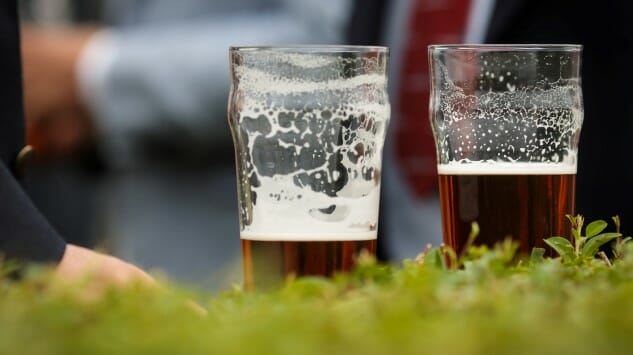Brewery Taprooms: Please Allow Half Pours. I’m Begging You.
Photo via Getty Images, Jack Taylor and Jim Vorel
There was a time when I was happy to walk into a brewery taproom and simply accept whatever I was given. In the heady, earlier days of the craft beer boom, simply being able to get fresh, local beer was really novelty enough. But people get older. Their palates change, and the common offerings produced by the industry change with them. The demographic of “craft beer drinker” ages along with you. And one day, you wake up and realize that the prevailing way of drinking beer at many breweries has simply become too limiting.
What I’m getting at is this: “Half pours” at brewery taprooms are great for the consumer. They serve a niche, allow for greater flexibility as a customer and help promote responsible consumption. They may complicate the serving process slightly for breweries (although far less than flights), but they really should be a universal part of the brewery taproom landscape by this point.
To be certain, many breweries do now offer half pours in their taprooms, whether that equates to a 6, 8 or 10 oz pour of any given beer. Some may charge a bit more per ounce for the inconvenience of pouring smaller glasses, but to be honest, I don’t really mind—I’m just pleased to have the option, and I’m not the only one who feels this way. What really seems like a missed opportunity, though, are the breweries that still aren’t offering any middle ground between “pints” and “tastes.”
A Matter of Experience
Make no mistake, there are still plenty of breweries out there exclusively serving beer via “pints” and “flights.” Just last week I ran into this situation not once, but twice in the Atlanta area while visiting brewery taprooms. In both locations, beers were available as either 16-20 oz pints, or within the context of a four or five beer flight of 4 oz taster glasses—no volumes in between.
Yes, as someone is no doubt preparing to type to me in an angry missive, the serving of half pours can sometimes necessitate the purchase and storing of new glassware, which is an expense/investment some breweries don’t want to make. However, that doesn’t stop some of my favorite breweries from simply offering “half pints” or half pours in their standard glassware, which is simply filled to a halfway mark. In these cases, the breweries incurred no extra expense, but are able to offer a much more flexible experience, just because they chose to make half pours available.
And that’s just it—one of the biggest arguments in favor of half pours is the issue of the customer’s drinking experience. If you’ve been drinking from taster glasses in brewery taprooms for years, you probably know exactly what I’m talking about. Put simply, a 4 oz tasting glass (even when properly filled, which many aren’t) often isn’t a great way of truly appraising a new beer you’ve never sampled before. For one thing, they warm very quickly, which might be desirable for an imperial stout, but is hardly what you want most of the time in a sample of lager or pale ale. You might be saying “so drink it quickly, then,” but what happens when you’ve got five glasses in your flight? Even drinking at a normal rate, the tasters you get to later tend not to be at their best, especially if you’re outside on a patio on a warm summer day. Rarely is the best version of any beer the one you drink from a 4 oz taster glass.
 Flights serve a purpose, but they’re cumbersome for employees and rarely the optimal way to appreciate any given beer.
Flights serve a purpose, but they’re cumbersome for employees and rarely the optimal way to appreciate any given beer.
-

-

-

-

-

-

-

-

-

-

-

-

-

-

-

-

-

-

-

-

-

-

-

-

-

-

-

-

-

-

-

-

-

-

-

-

-

-

-

-








































